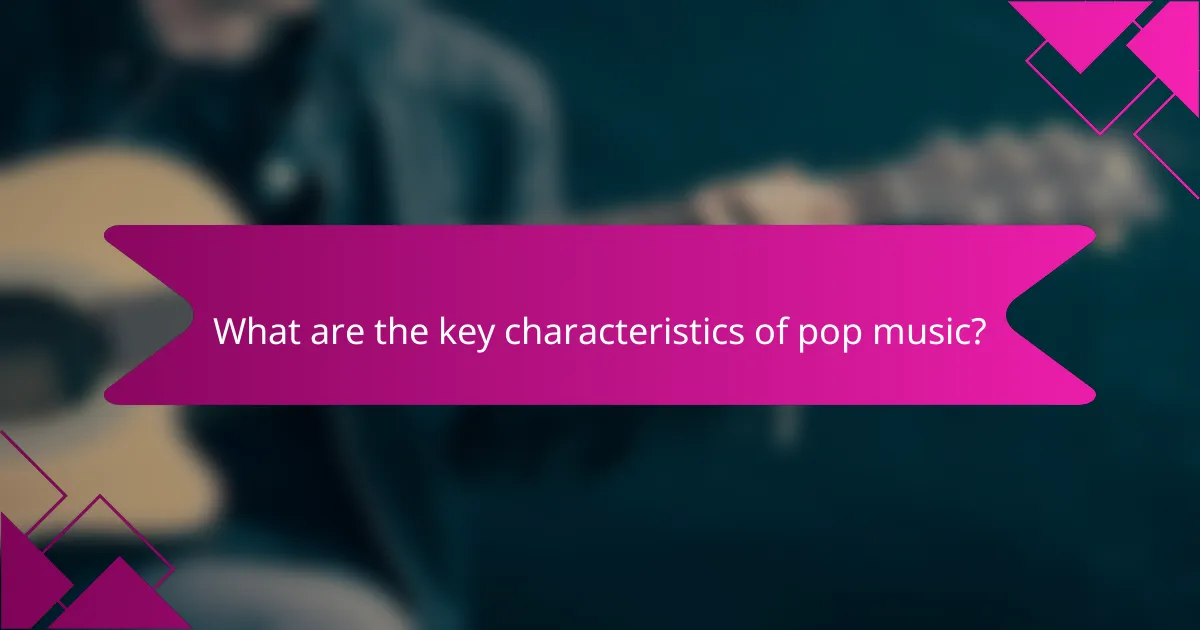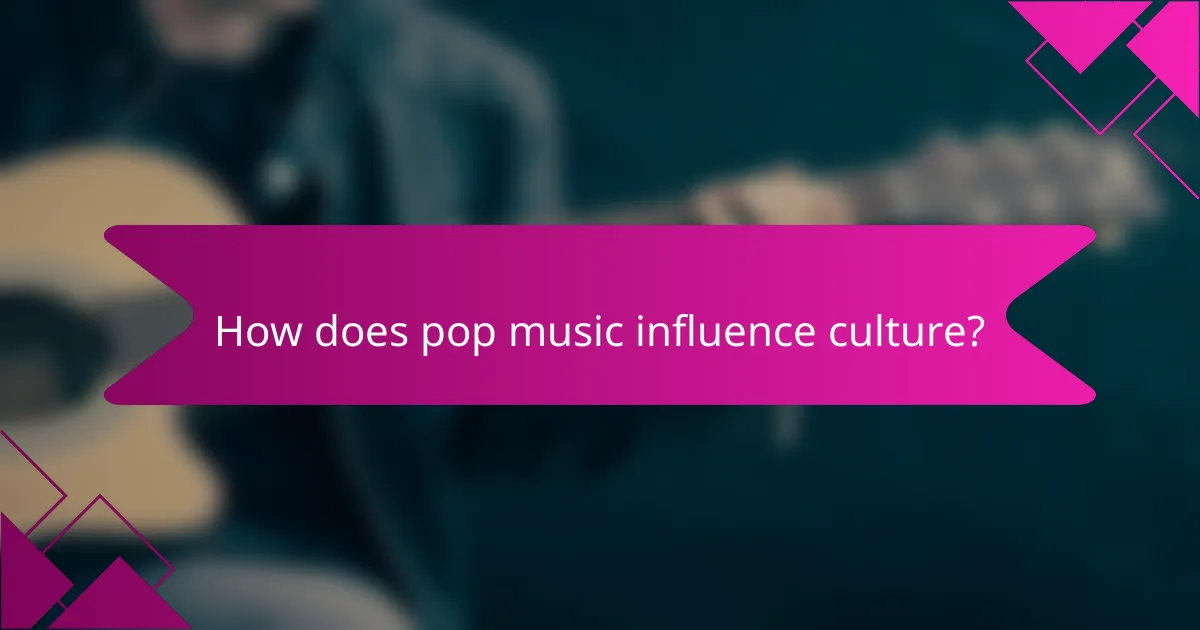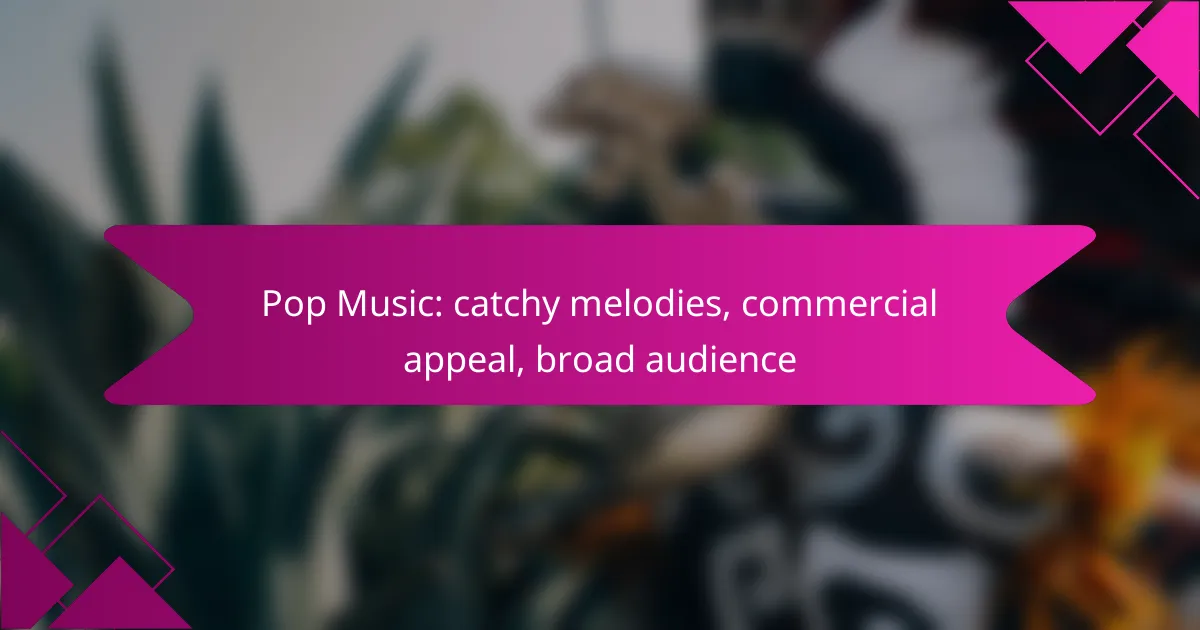Pop music is renowned for its catchy melodies and commercial appeal, making it one of the most accessible genres for a wide audience. The genre thrives on simplicity and memorable hooks, often enhanced through collaboration among artists and producers. This universal appeal has allowed pop music to dominate the charts and resonate with listeners across the globe.

How to create catchy pop music?
Creating catchy pop music involves crafting melodies and lyrics that resonate with a wide audience. Focus on simplicity, memorable elements, and effective collaboration to enhance your commercial appeal.
Use simple chord progressions
Simple chord progressions form the backbone of many successful pop songs. Common sequences like I-IV-V or I-V-vi-IV are easy to remember and sing along to, making them ideal for catchy melodies.
Stick to a few chords, typically three to five, to maintain clarity and accessibility. This approach allows listeners to engage quickly without feeling overwhelmed by complexity.
Incorporate memorable hooks
A memorable hook is a crucial element that makes a song stick in listeners’ minds. This can be a catchy melody, a unique lyrical phrase, or a distinctive instrumental riff that captures attention.
Consider using repetition in your hooks to reinforce their memorability. A well-placed hook can elevate a song’s appeal and encourage listeners to replay it, increasing its chances of commercial success.
Utilize repetition effectively
Repetition is a powerful tool in pop music that helps solidify melodies and lyrics in the audience’s memory. Repeating phrases or sections can create familiarity, making the song more enjoyable and easier to remember.
However, balance is key; overusing repetition can lead to monotony. Aim for a structure that includes repeated elements while still offering enough variation to keep the listener engaged.
Experiment with tempo and rhythm
Tempo and rhythm play significant roles in the catchiness of pop music. A lively tempo, often between 100-130 BPM, can energize listeners and encourage movement, while varied rhythmic patterns can add interest.
Don’t hesitate to mix different rhythms within a song to create dynamic contrasts. This can enhance the overall feel and keep the audience captivated throughout the track.
Collaborate with established producers
Working with experienced producers can greatly enhance the quality of your pop music. They bring valuable insights, industry knowledge, and technical skills that can elevate your sound and broaden your reach.
Choose producers who have a track record of successful pop hits, as their expertise can help you navigate the commercial landscape and refine your music to meet audience expectations.

What are the key characteristics of pop music?
Pop music is defined by its catchy melodies, commercial appeal, and ability to reach a broad audience. These characteristics make it one of the most popular and recognizable genres in the music industry.
Catchy melodies
Catchy melodies are a hallmark of pop music, designed to be memorable and easily singable. They often feature simple, repetitive structures that encourage listener engagement and retention. For example, many pop songs utilize hooks that repeat throughout the track, making them instantly recognizable.
Songwriters often focus on creating a strong chorus that stands out, as this is typically the part that listeners remember most. A good melody can elevate a song’s appeal and contribute significantly to its success on the charts.
Commercial appeal
Commercial appeal in pop music refers to its ability to attract a wide audience and generate sales. This is often achieved through relatable lyrics, engaging rhythms, and polished production. Songs that resonate with listeners’ everyday experiences tend to perform better commercially.
Record labels often invest heavily in marketing pop songs to maximize their reach, utilizing platforms like radio, streaming services, and social media. Successful pop tracks frequently become cultural phenomena, leading to increased merchandise sales and concert attendance.
Broad audience reach
Pop music is designed to appeal to a diverse audience, cutting across age, gender, and cultural lines. This broad reach is achieved through universal themes and accessible sounds, making it easy for listeners from various backgrounds to connect with the music.
Artists often collaborate with producers and songwriters who understand market trends, ensuring that their music aligns with current tastes. This strategy helps pop songs gain traction across multiple demographics, increasing their chances of becoming hits.
Production quality
High production quality is essential in pop music, as it enhances the overall listening experience. Professional studios, skilled engineers, and advanced technology are commonly used to create polished tracks that stand out in a competitive market.
Elements such as layered vocals, intricate instrumentation, and electronic effects are often employed to create a rich sound. Investing in quality production can significantly impact a song’s success, as listeners tend to favor well-crafted music over lower-quality recordings.

Which artists define modern pop music?
Modern pop music is characterized by catchy melodies and commercial appeal, with several artists leading the genre. Key figures like Taylor Swift, Dua Lipa, Ed Sheeran, and Ariana Grande have significantly shaped the sound and reach of contemporary pop, attracting broad audiences worldwide.
Taylor Swift
Taylor Swift is a defining artist in modern pop, known for her narrative songwriting and genre versatility. Transitioning from country to pop, her albums often feature relatable themes that resonate with a wide demographic, making her music commercially successful.
Her ability to reinvent her sound while maintaining a strong connection with fans has led to numerous chart-topping hits. Swift’s strategic use of social media also enhances her engagement with audiences, further solidifying her status in the pop music landscape.
Dua Lipa
Dua Lipa has emerged as a prominent figure in modern pop, recognized for her distinctive voice and danceable tracks. Her debut album, “Dua Lipa,” featured hits that combined elements of disco and electronic music, appealing to a diverse audience.
With a focus on empowerment and self-confidence in her lyrics, Lipa’s music often resonates with younger listeners. Her collaborations with other artists and producers have also expanded her reach, making her a staple in contemporary pop playlists.
Ed Sheeran
Ed Sheeran is a significant contributor to modern pop, known for his emotive songwriting and acoustic sound. His blend of pop, folk, and R&B elements has produced numerous hits that appeal to a broad audience, often topping charts globally.
Sheeran’s approach to music includes storytelling and relatable themes, which have garnered him a loyal fanbase. His collaborations with various artists across genres have further enhanced his influence in the pop music scene.
Ariana Grande
Ariana Grande is a leading artist in modern pop, celebrated for her powerful vocals and impressive range. Her music often features catchy hooks and themes of love and empowerment, making her relatable to many listeners.
Grande’s ability to blend pop with R&B influences has resulted in a unique sound that resonates across age groups. She has consistently produced chart-topping singles and albums, solidifying her position as a key player in the contemporary pop landscape.

How does pop music influence culture?
Pop music significantly influences culture by shaping societal norms, trends, and behaviors. Its catchy melodies and commercial appeal resonate with a broad audience, making it a powerful medium for cultural expression and change.
Shapes fashion trends
Pop music often dictates fashion trends by showcasing styles through music videos, performances, and celebrity endorsements. Artists like Billie Eilish and Harry Styles have popularized unique fashion choices that fans eagerly adopt, reflecting their admiration and desire to connect with the music. This influence can lead to rapid shifts in clothing styles, accessories, and even beauty standards.
For example, the resurgence of 90s fashion can be traced back to pop stars who incorporate vintage elements into their wardrobes. As a result, brands often collaborate with musicians to create limited-edition collections that capitalize on these trends.
Drives social movements
Pop music serves as a catalyst for social movements by raising awareness and inspiring action on various issues. Artists frequently use their platforms to address topics like mental health, equality, and climate change, encouraging fans to engage with these causes. Songs with powerful messages can mobilize listeners and foster a sense of community around shared values.
For instance, tracks like “Fight Song” by Rachel Platten have become anthems for empowerment, while artists like Beyoncé have highlighted racial and gender issues through their music and performances. This connection between pop music and activism can amplify the reach and impact of social movements.
Impacts language and slang
Pop music influences language and slang by introducing new phrases and expressions into everyday conversation. Catchy lyrics often become part of popular vernacular, as fans adopt them in social interactions and online communication. This phenomenon can lead to the rapid evolution of language, particularly among younger generations.
For example, phrases from hit songs can quickly become trendy, reflecting cultural shifts and the interests of the audience. Additionally, artists often play with language, creating unique slang that resonates with listeners and encourages them to express themselves in new ways.
